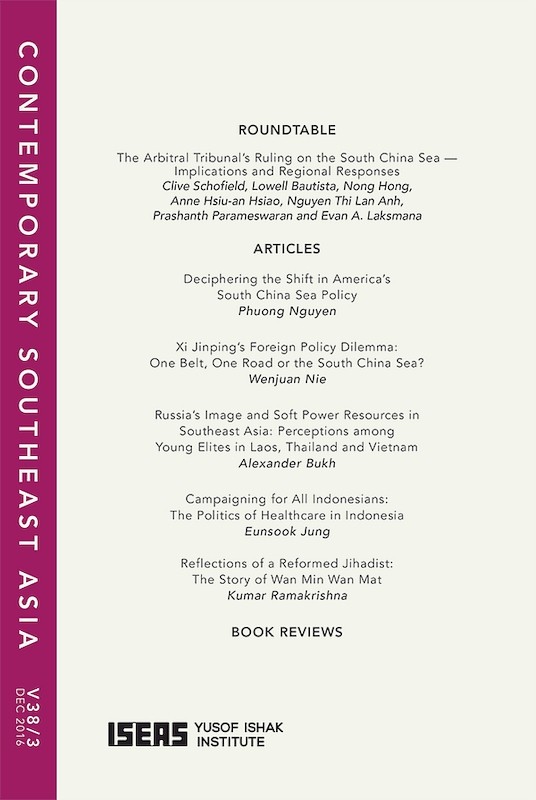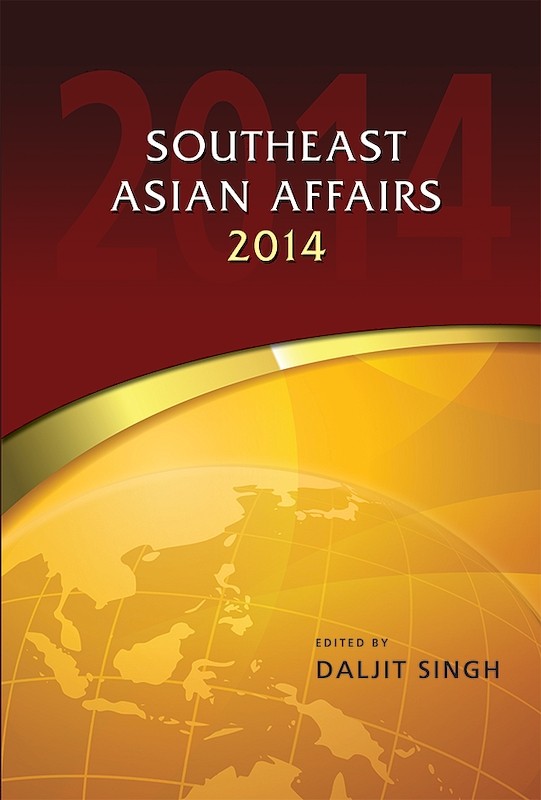Journal of Southeast Asian Economies Vol. 33/2 (Aug 2016). Special Focus on “(De)centralization in Southeast Asia”

Date of publication:
August 2016
Publisher:
ISEAS – Yusof Ishak Institute
Number of pages:
148
Code:
AE33/2
Contents
-
Journal of Southeast Asian Economies Vol. 33/2 (Aug 2016). Special Focus on "(De)centralization in Southeast Asia"
[Whole Publication, ISSN: 23395206] -
Preliminary pages
- ARTICLES
-
1. Varieties of Disappointment: Why Has Decentralization Not Delivered on Its Promises in Southeast Asia?, by Edmund J. Malesky, Francis E Hutchinson, authors see abstract<font face="helvetica, arial, verdana, sans-serif"><span style="font-size: 13px;">With varying levels of intensity, Southeast Asian countries have been experimenting with different modes of decentralization for over two decades. Significant debate exists about the success of these efforts, and some countries have recently attempted to reverse these measures by recentralizing political, fiscal, or administrative authority. To better understand the arguments over these institutional changes, we commissioned a set of articles from world-class scholars on the region, asking them to reflect on decentralization/recentralization debates within their countries of study. In this introductory article, we explore some of the key themes and findings from these contributions. An unmistakable tone of negativity pervades the pieces. Authors express either disappointment that decentralization did not achieve its lofty goals or was never given a chance to succeed by central leaders who: were reluctant to fully devolve power; issued contradictory legislation that undermined decentralization’s effectiveness; or used alternative levers to recentralize authority to negate the incipient decentralization measures. We probe some of the main drivers of the disappointment and offer some conjectures about the future of decentralization in the region.</span></font>
-
2. Indonesia’s Decentralization Experiment: Motivations, Successes, and Unintended Consequences, by Kai Ostwald, Yuhki Tajima, Krislert Samphantharak, authors see abstract<font face="helvetica, arial, verdana, sans-serif"><span style="font-size: 13px;">Since 2001, Indonesia has undergone a rapid and extensive programme of decentralization of governance and resources from the centre to local level. This devolution has created a new class of regional political elites and has shifted significant power back to sub-national levels in Indonesia’s centuries’ long history of centre-local tensions. While the political motivations of mitigating centrifugal pressures appear to be vindicated, the anticipated gains in service provision and downstream economic impacts have not uniformly materialized: efficiency gains in some regions have been offset by the widespread emergence of clientalistic practices and fiscal inefficiencies. Recent efforts towards limited administrative and political recentralization underscore the tension that remains between the centre and local governments.</span></font>
-
3. The Causes and Effects of the Local Government Code in the Philippines: Locked in a Status Quo of Weakly Decentralized Authority?, by Sarah Shair-Rosenfield, author see abstract<font face="helvetica, arial, verdana, sans-serif"><span style="font-size: 13px;">In 1991, the Local Government Code (LGC) of the Philippines endowed three distinct levels of government with substantial policy authority. While the LGC was designed to encourage local government units to be more self-reliant and promote economic development programmes tailored to local needs, clan politics, wide-spread corruption, and local elite incompetence have constrained improvements in the delivery of services and growth. Despite decentralization’s mixed record, the status quo established by the LGC has remained as a result of opposing pressures by empowered local elites and a central government averse to supplying them with additional power or resources. Efforts in recent years have instead focused on upgrading the quality of service delivery by improving local government reporting and accountability mechanisms, rather than addressing the structure of decentralization.</span></font>
-
4. Decentralization in Thailand, by Danny Unger, Chandra Mahakanjana, authors see abstract<font face="helvetica, arial, verdana, sans-serif"><span style="font-size: 13px;">While close to 8,000 local bodies operate in provinces, municipalities, and sub-districts, Thailand is a highly centralized state. This is largely due to control over provincial and district level governments by the powerful Ministry of Interior (MoI). In the late 1990s, substantial political and fiscal decentralization reforms were introduced. In particular, the 1999 Decentralization Plan and Procedures Act called for the establishment of a National Decentralization Committee and the formulation of a Decentralization Master Plan. However, with civil society and political parties generally weak, political and policy processes have often been dominated by actors who mistrust decentralization processes. Due to this, the administrative structure overseen by the central MoI has remained in place and become intertwined with the strengthened institutions of political decentralization. While they may seem to be opposed to each other, it is possible that these two distinct systems of accountability may complement, rather than compete, with each other.</span></font>
-
5. Vietnam: Decentralization Amidst Fragmentation, by Vu Thanh Huong, author see abstract<font face="helvetica, arial, verdana, sans-serif"><span style="font-size: 13px;">Since Doi Moi (1986), decentralization in Vietnam has been expanded, but still limited to fiscal and administrative rather than political decentralization. From the central perspective, decentralization has undermined the uniformity of national policies and encouraged unhealthy competition among local governments. For local governments, decentralization has not always been accompanied by institutional autonomy and sufficient financial resources. Moreover, there has been a lack of synchronization between central ministries as well as consistency between the different dimensions of decentralization. Finally, the people and businesses have neither been adequately involved nor had sufficient voice in the most important decentralization policies. This article analyses common and cross-cutting issues shared by different dimensions of decentralization in Vietnam since Doi Moi. It shows that serious institutional fragmentation has rendered decentralization ineffective. Given Vietnam’s political economy, the first priority in designing decentralization policy is to overcome this fragmentation and prepare the prerequisites for effective and efficient decentralization.</span></font>
-
6. Decentralization Reforms in Cambodia, by Netra Eng, Sophal Ear, authors see abstract<font face="helvetica, arial, verdana, sans-serif"><span style="font-size: 13px;">Change and continuity in decentralization reforms in Cambodia varied widely since the end of the Khmer Rouge period. During the immediate aftermath, local actors had substantial power and discretion over services and revenues as a result of constraints at the time. We assess Cambodia’s formal decentralization reform and its outcomes for accountability and democracy after decentralized institutions and elected councils were created at the commune and district levels in 2002 and 2009, respectively. We explain the political significance of the reform from the perspective of the government and leaders of the ruling party and the extent to which decentralization fits in with the party’s strategy for legitimacy. The outcomes of decentralization reforms for accountability and democracy were shallow even though local elections and participatory governance were institutionalized. The decentralized actors were constrained in their responsiveness and accountability to local citizens due to their lack of authority and autonomy over key service delivery functions and resources.</span></font>
-
7. Decentralization in Myanmar: A Nascent and Evolving Process, by Kim N B Ninh, Matthew Kosuta, authors see abstract<font face="helvetica, arial, verdana, sans-serif"><span style="font-size: 13px;">Under the 2008 Constitution and following the 2010 elections marking Myanmar’s historic transition from military rule, the country began a series of decentralization reforms. Sub-national governance is now based on fourteen state and region governments, with more opportunities for public inputs at the local level. Myanmar, however, remains a highly centralized state: 25 per cent of national and sub-national parliamentary seats are constitutionally mandated for the military. Furthermore, the state and region governments have no civil service of their own and must rely on national ministries. While even the military now concedes that the country’s future lies in some form of federalism, what that means will be highly contested given the history of ethnic armed conflicts. Meanwhile, state and region governments are becoming more active in defining their own policies, developments that the new National League for Democracy-led government has promised to further.</span></font>
- RESEARCH NOTE
-
Things Have Changed: Returns to Education in Thailand, by Niels-Hugo Blunch, author see abstract<font face="helvetica, arial, verdana, sans-serif"><span style="font-size: 13px;">This study examines the developments in educational attainment and education returns of wage earners in Thailand over the period 1994–2002. In so doing, several potential weaknesses of previous studies on the topic — as well as, more generally, applied econometrics analyses — are addressed. One contribution of this paper is to gather and re-emphasize the importance of several important estimation issues frequently overlooked by researchers. The results imply that the returns to education in Thailand over the period are substantial, peaking in 2000. Taking into account the possible endogeneity of education using household fixed effects, education returns are substantially dampened, relative to the baseline ordinary least squares estimates. This indicates that previous studies for Thailand and elsewhere — when not taking endogeneity into account — may have overestimated the returns to education substantially.</span></font>
- BOOK REVIEWS
-
BOOK REVIEW: ASEAN, PRC and India: The Great Transformation, by Asian Development Bank Institute, by Rahul Mishra, author
-
BOOK REVIEW: Routledge Handbook of Southeast Asian Economics, edited by Ian Coxhead, by Francis E Hutchinson, author
-
BOOK REVIEW: Economic Integration in East Asia: Production Networks and Small and Medium Enterprises, by Charles Harvie, Dionisius Narjoko and Sothea Oum, by Wai Heng Loke, author
-
BOOK REVIEW: The Foundation of the ASEAN Economic Community: An Institutional and Legal Profile, by Stefano Inama and Edmund W. Sim, by Myrna S Austria, author
-
BOOK REVIEW: Rules of Origin in ASEAN: A Way Forward, by Stefano Inama and Edmund W. Sim, by Zamroni Salim, author
-
BOOK REVIEW: From Community to Compliance? The Evolution of Monitoring Obligations in ASEAN, by Simon Chesterman, by Termsak Chalermpalanupap, author
-
BOOK REVIEW: A Critical Study of Thailands Higher Education Reforms, by Rattana Lao, by Nopraenue Sajjarax Dhirathiti, author
-
BOOK REVIEW: Innovation Networks and the New Asian Regionalism: A Knowledge Platform on Economic Productivity, by Hans-Peter Brunner , by Jayarethanam Pillai, author






